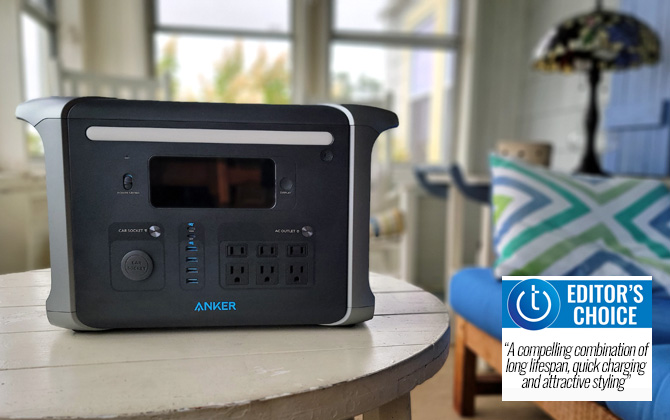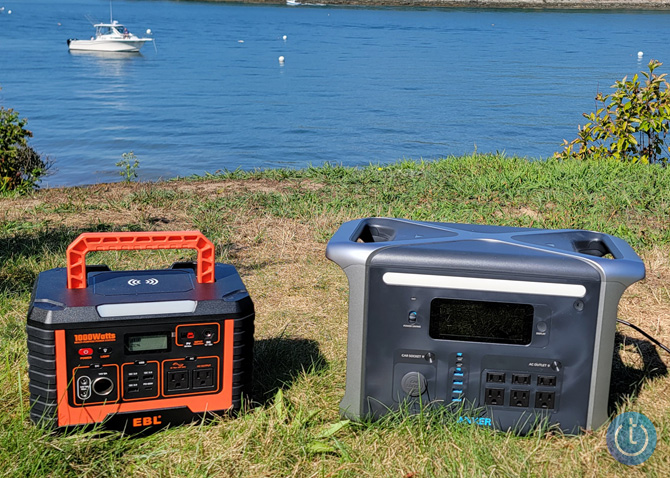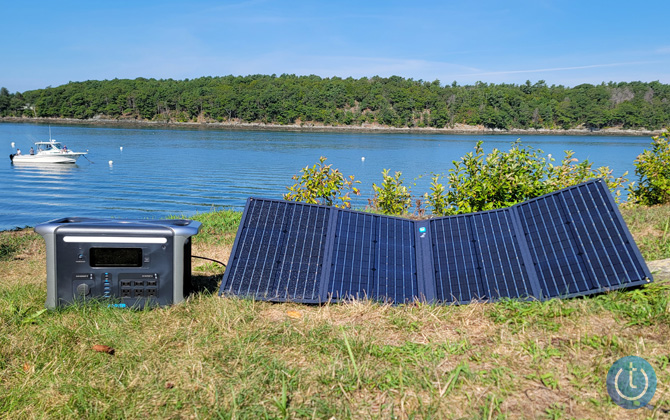We may earn commissions when you buy from links on our site. Why you can trust us.
Anker 757 PowerHouse: A Portable Generator with Extra-Long Lifespan
When my family went to Maine this summer, the cottage we stayed in has occasional power outages and, even when power is on, it's dark and has few outlets to plug in our devices. So, I took the opportunity to pack the 1229Wh Anker 757 PowerHouse ($1,399.99, on sale now for $1,249.99) to provide working outlets for lights and the coffee maker and charging ports for our phones and laptops.
The 757 PowerHouse is a power station, a type of generator that runs on batteries instead of fuel and is safe to use and store indoors. Unlike most other power stations, which use lithium-ion or lithium NCM batteries, the 757 PowerHouse uses lithium iron phosphate (LFP) batteries. LFP batteries have six times as many charge cycles as other lithium-based batteries, giving the 757 PowerHouse an extra-long lifespan of 10 years.
While I couldn't assess the battery's lifespan, I spent more than a week testing the power and recharging capabilities of the 757 PowerHouse. I found it to be an attractive, well-built product that is a great choice for emergency backup power. Anker's LFP product is noticeably larger and heavier than similarly specced lithium-battery-based power stations, but the extra charging cycles are more than a fair tradeoff.

|
+ Pros |
– Cons |
|
|
Design
The 1229Wh Anker 757 PowerHouse has a large array of charging ports and styling that's attractive enough you won't mind leaving it out in your home. However, it's bigger and heavier than similar capacity lithium-ion or Lithium NCM power stations at 18.2 by 11.3 by 9.3 inches and 43.9 pounds, just barely portable for me. In comparison, the slightly lower capacity 999Wh EBL Voyager 1000 ($999.00) measures 11.5 by 8 by 8 inches and weighs just 18.7 pounds.

The 757 PowerHouse has plenty of charging ports and outlets. There are six USB ports – one 100-watt USB-C, one 60-watt USB-C, and four 12-watt USB-A – which are stacked in a tower. I'd like them spaced out a little more, but it's fine. The real problem is with the six AC outlets. They are packed so tightly together that most power adapters will cover up the adjacent outlets. Also, only three of the outlets are the three-prong grounded variety. So, you may need to invest in adapters to make everything fit. There is also a DC car charger port. In total, you can charge up to 13 devices simultaneously.
A large 5-inch display on the front makes it easy to see how much power you have left, how many watts you're currently using, which ports are active, your charging mode, and more. So, for instance, when I plugged in a vacuum cleaner, I could see immediately how it impacted the remaining battery life.
At the top of the front panel is an LED light with three light levels. Often the light on these power stations is a bright white, but Anker chose a warm white, which wouldn't be out of place near a campfire.
On the back, you'll find the inputs for charging. You can charge via a regular AC outlet, your car's DC charger port, or solar panels (up to three). Cables for all methods of charging come in the box.
The 757 PowerHouse does not have an IP rating for water and dust resistance. Therefore, I would not recommend using it outdoors in places where it will be exposed to rain and dirt or sand.
Use
Using the Anker 757 PowerHouse is simple. For USB charging, you plug in your device, and it begins charging. The AC outlets and the DC car-charger port have power buttons you need to turn on before they work. The AC and DC outlets will slowly drain the battery if they are on, but you can activate Power Saving mode, which will turn off the power station once your devices are fully charged.
You can use the 757 PowerHouse as an uninterruptible power supply (UPS) in addition to using it as your primary power source. To use it as a UPS, keep the 757 PowerHouse connected to an AC outlet and your equipment plugged into the 757 PowerHouse. Then, if the power goes out, the power station will immediately start providing power from its battery.
Charging
Only a few power stations are capable of super-fast charging, including the Anker 757 PowerHouse. It takes just an hour and a half to fully recharge from a standard AC outlet and an hour to charge to 80 percent. That's because the 757 PowerHouse can accept a 1,000-watt input, one of the highest on the market. A single solar panel (100 watts) or a car charger (120 watts) will take significantly longer.

Anker claims 3,000 charging cycles and estimates the product will last ten years. In comparison, the maximum number of cycles for lithium-ion-based power stations is usually around 500 cycles, with a maximum of about 1,000 cycles. While I couldn't test the lifespan, the LFP battery technology is widely known to be able to attain the charge cycles that Anker claims.
The bottom line
If you're looking for a generator or UPS to help you ride out power outages, the Anker 757 PowerHouse ($1,399.99, on sale now for $1,249.99) should be on your shortlist. It is large and heavy, and the AC outlets are packed too closely together, but it's also well-built and stylish, making it blend into your décor. And for what matters most – recharge time and charging cycles – it's everything you want in a portable power station.
[Image credit: Techlicious]
For the past 20+ years, Techlicious founder Suzanne Kantra has been exploring and writing about the world’s most exciting and important science and technology issues. Prior to Techlicious, Suzanne was the Technology Editor for Martha Stewart Living Omnimedia and the Senior Technology Editor for Popular Science. Suzanne has been featured on CNN, CBS, and NBC.















